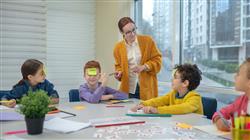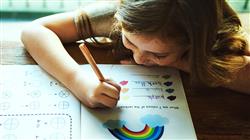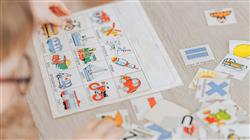University certificate
The world's largest school of languages”
Why study at TECH?
Bilingual Education is booming. This university program will introduce you to a successful educational model at an early age”

Conventional methods in language teaching, such as expository classes or mechanical exercises, slow down learning and seriously affect the motivation of students. Nowadays, with the incursion of new technologies in the classroom, the educational landscape has been transformed allowing the inclusion of numerous ICT resources, which make learning more attractive.
At the same time, the advance of bilingual teaching in educational centers has increased the demand and, therefore, the demand for teaching professionals dedicated to the teaching of languages or those who must teach subjects of other subjects in a second language. A boom in a sector that represents an excellent opportunity for teaching professionals, who, in turn, take on the challenge of ensuring that their students acquire solid and effective knowledge for their cognitive and personal development.
In this scenario, this Professional master’s degree provides the possibility of acquiring intensive and advanced learning in Bilingual Education in Pre-School and Primary School, preparing students to teach classes in a second language and with the most updated technological resources. Therefore, from the beginning you will learn about the concept of the bilingual educational model, the role of the teacher, early literacy in bilingual children or the different systems used in these levels of education.
In addition, through video summaries, videos in detail, interactive diagrams or specialized readings, students will learn about the organization of a bilingual center, the attention to students with Special Educational Needs or the figure of the conversation assistant. Likewise, case studies will lead the graduate to delve into successful projects in which Project Based Learning has been used.
TECH offers a quality program within everyone's reach, where students only need an electronic device with an Internet connection to view the syllabus at any time of the day. Therefore, without the need for attendance or classes with fixed schedules, the graduate can combine a university education with their professional and/or work responsibilities.
Progress in your professional career thanks to this Professional master’s degree. Put into practice all the knowledge it provides and you will succeed as a bilingual teacher”
This Professional master’s degree in Bilingual Education in Pre-School and Primary School contains the most complete and up-to-date program on the market. The most important features include:
- The development of case studies presented by experts in Bilingual Education in Pre-School and Primary School
- The graphic, schematic and practical contents of the book provide technical and practical information on those disciplines that are essential for professional practice.
- Practical exercises where the self-assessment process can be carried out to improve learning
- Its special emphasis on innovative methodologies
- Theoretical lessons, questions to the expert, debate forums on controversial topics, and individual reflection work.
- Content that is accessible from any fixed or portable device with an Internet connection.
Learn about the main factors that influence the development of Project Based Learning. Enroll now"
The program’s teaching staff includes professionals from the field who contribute their work experience to this educational program, as well as renowned specialists from leading societies and prestigious universities.
The multimedia content, developed with the latest educational technology, will provide the professional with situated and contextual learning, i.e., a simulated environment that will provide immersive education programmed to learn in real situations.
This program is designed around Problem-Based Learning, whereby the professional must try to solve the different professional practice situations that arise during the course. For this purpose, the student will be assisted by an innovative interactive video system created by renowned and experienced experts.
This Professional master’s degree will show you the most successful educational actions in the field of Bilingual Education. Enroll now to access"

The library of didactic resources is available 24 hours a day so that you can access them whenever you want from your computer"
Syllabus
The syllabus of this Professional master’s degree has been designed to provide students, over 12 months, with the most advanced and comprehensive knowledge about Bilingual Education. Through a theoretical-practical approach, the graduate will be able to learn about the different technological tools available to make their classes more attractive. Likewise, they will learn the most commonly used didactic resources in a bilingual classroom, such as the different types of games, songs, the use of puppets or making crafts. In addition, with the Relearning learning system, based on the repetition of content, students will be able to progress through this curriculum in a much more natural way and even reduce the long hours of study.

With this university education you will acquire the knowledge you need to design flipped classroom or cooperative learning sessions”
Module 1. Principles of Bilingualism
1.1. Definition and History of Bilingualism
1.1.1. Definition of Bilingualism
1.1.2. Languages in Contact
1.1.3. Definition of Multilingualism
1.1.4. Multilingualism in The World
1.1.5. Types of Multilingualism
1.2. Models of Bilingualism in Education
1.2.1. Bilingualism in Education
1.2.2. Models of Bilingual Education
1.2.3. Models of Bilingualism in the world
1.2.4. Bilingualism in Canada
1.2.5. Bilingualism in the USA
1.2.6. Bilingualism in Spain
1.2.7. Bilingualism in Latin America
1.3. The Cultural Dimension of Bilingualism
1.3.1. Intercultural Bilingual Education (IBE)
1.3.2. The History of the IBE
1.3.3. Bilingualism and Cultural Diversity in the Classroom
1.3.4. Bilingualism and Cultural Identity
1.4. The Role of the Mother Tongue in Bilingual Education
1.4.1. Language Acquisition in a Bilingual Context
1.4.2. Late Bilingualism and The Mother Tongue
1.4.3. The Mother Tongue and Emotions
1.4.4. The Mother Tongue in the Classroom
1.4.5. Use of Mother Tongue in the Foreign Language Classroom
1.5. Neuroeducation and Bilingualism
1.5.1. Bilingual Brain
1.5.2. The Age Factor
1.5.3. The Quality Factor
1.5.4. The Method Factor
1.5.5. The Language Factor
1.5.6. The Number Factor
1.6. Cummins' Theories on Bilingualism
1.6.1. Introduction
1.6.2. Linguistic Interdependence Theory
1.6.3. The Threshold Hypothesis
1.6.4. Additive and Subtractive Bilingualism
1.6.5. The Importance of the Mother Tongue
1.6.6. Language Immersion Programs
1.7. BICS and CALP
1.7.1. General Framework
1.7.2. Initial Theory
1.7.3. Definition of BICS
1.7.4. Definition of CALP
1.7.5. The Relationship between BICS and CALP
1.7.6. Contributions of the Theory
1.7.7. Criticisms of the Theory
1.8. Bilingualism in Pre-School
1.8.1. Languages in the Early Childhood Curriculum
1.8.2. Myths about Bilingualism in Early Ages
1.8.3. The Place of the Second Language in the Early Childhood Classroom
1.8.4. Routines
1.8.5. Working in Corners
1.8.6. Materials and Resources for Teaching English to Infants and Toddlers
1.9. Bilingualism in Primary School
1.9.1. Languages in the Primary Curriculum
1.9.2. Objectives of Bilingualism in Primary School
1.9.3. Bilingual Models in Primary School
1.9.4. Pros and Cons of Bilingualism in Primary School
1.9.5. The Role of the Environment in Success
1.10. The Role of the Bilingual Teacher
1.10.1. The Role of the Bilingual Teacher
1.10.2. The Bilingual Teacher as Intercultural Educator
1.10.3. Languages and the Bilingual Teacher
1.10.4. Training Needs
Module 2. Literacy in L2
2.1. Early Literacy in Bilingual Children
2.1.1. Definition of Early Literacy Growing Up in a Bilingual Family
2.1.2. Reading Stories in the Mother Tongue
2.1.3. Literacy in L2 as a Literate and Majority Language
2.1.4. Literacy in L2 as a Foreign Language
2.2. Influential Relationships between L1 and L2
2.2.1. Family Literacy
2.2.2. Mother Tongue Literacy in Schools
2.2.3. Impact of L1 Literacy o L2
2.2.4. Advantages of Using the Mother Tongue in the Bilingual Classroom
2.2.5. The Mother Tongue in Teaching English
2.3. Approaches to Literacy in English
2.3.1. Theories of Written Language Acquisition
2.3.2. Theories about Literacy in L2
2.3.3. Multiple Literacies
2.3.4. English as L2 Literacy Methods
2.4. English Phonetics
2.4.1. What is Phonetics
2.4.2. The Role of Phonics in L2 Learning
2.4.3. Characteristics of English Phonetics
2.4.4. Phonetics or Phonology for the English Classroom
2.5. Synthetic Method: Phonemic Awareness
2.5.1. Definition of Phonologic and Phonemic Conscience
2.5.2. Phonemic Conscience and Learning English as L2
2.5.3. How to Work at Home
2.5.4. How to Work in the Classroom
2.6. Synthetic Method: Phonics
2.6.1. Characteristics of the Phonics Method
2.6.2. Introduction to Jolly Phonics Method
2.6.3. The Five Skills that are Worked on
2.6.4. Materials and Resources
2.6.5. Other Resources Phonic Readers, Videos, Songs
2.7. Globalized Reading "Whole Language"
2.7.1. Principles of a Globalized Approach
2.7.2. Chomsky and Goodman
2.7.3. Implications for Teaching English as an L2
2.7.4. Activities and Resources
2.7.5. The Concept of "Integrated Literacy”, Balanced Literacy
2.8. Working with Readers/Graded Readings
2.8.1. Definition of Readers and Characteristics
2.8.2. Advantages of Extensive Reading
2.8.3. Strategies for Using Readers in the Classroom
2.8.4. Activities with Readers in the Classroom
2.9. Picture Books
2.9.1. Reasons for Using Storytelling in the Classroom
2.9.2. Definition and Characteristics of an Illustrated Album
2.9.3. Selection Criteria
2.9.4. Activities and Strategies of Use
2.9.5. Classic Picture Books of English Literature
2.10. Storytelling. Oral Narration
2.10.1. Oral Narration in the Classroom
2.10.2. Reading or Telling a Story
2.10.3. Oral Narration as an L2 Teaching Tool
2.10.4. Keys to Oral Narration
2.10.5. Activities for Before, During, and After the Oral Narration.
2.10.6. Collective Oral Narration
Module 3. English in the Bilingual Classroom
3.1. L2 Learning. Methods and Approaches
3.1.1. From Grammar to Communication
3.1.2. Grammar-Translation Method
3.1.3. Natural Method
3.1.4. Total Physical Response
3.1.5. Audio-Lingual Method
3.1.6. Sugestopedia
3.1.7. Communicative Approach
3.2. L2 Learning at an Early Age (0-6)
3.2.1. Myths and Facts about Early L2 Learning
3.2.2. The Age Factor in L2 Learning
3.2.3. Benefits of Early L2 Acquisition
3.2.4. Stages of Early L2 Acquisition
3.2.5. Relations with Families
3.2.6. Benefits of Early L2 Acquisition
3.3. L2 and Interaction
3.3.1. The Role of Interaction in Learning
3.3.2. Interaction in Native Language Learning
3.3.3. Interaction in L2 Learning
3.3.4. Types of Interaction in the Foreign Language Classroom
3.3.5. Teacher Talking Time
3.4. The Role of Emotions in L2 Learning
3.4.1. Emotions and Learning
3.4.2. The Output Theory
3.4.3. How Anxiety Affects
3.4.4. Emotions and Trust
3.4.5. Motivation
3.5. English Communication Skills
3.5.1. The Integration of Communicative Skills
3.5.2. CEFR (Common European Framework of Reference for Languages)
3.5.3. Levels of Reference
3.6. Listening
3.6.1. Definition of Listening
3.6.2. Techniques and Tools for Teaching Listening
3.6.3. Activity Examples
3.6.4. Before the Activity
3.6.5. During the Activity
3.6.6. After the Activity
3.7. Reading
3.7.1. Definition of Reading
3.7.2. Techniques and Tools for Teaching Reading
3.7.3. Activity Examples
3.7.4. Before the Activity
3.7.5. During the Activity
3.7.6. After the Activity
3.8. Speaking
3.8.1. Definition of Speaking
3.8.2. Techniques and Tools for Teaching Speaking
3.8.3. Activity Examples
3.8.4. Before the Activity
3.8.5. During the Activity
3.8.6. After the Activity
3.9. Writing
3.9.1. Definition of Writing
3.9.2. Techniques and Tools for Teaching Writing
3.9.3. Activity Examples
3.9.4. Before the Activity
3.9.5. During the Activity
3.9.6. After the Activity
3.10. Assessment
3.10.1. How to Assess Listening
3.10.2. How to Assess Reading
3.10.3. How to Assess Speaking
3.10.4. How to Assess Writing
Module 4. CLIL Methodology
4.1. Objectives and Fundamentals
4.1.1. Definition
4.1.2. Basic Principles
4.1.3. Types of CLIL
4.1.4. Advantages of CLIL
4.2. Relationships Between Content and Language
4.2.1. Features of the CLIL Curriculum
4.2.2. The Teaching Language
4.2.3. Language as a Vehicle
4.2.4. Language as a Learning Goal
4.3. Scaffolding in CLIL
4.3.1. The Importance of Scaffolding in CLIL
4.3.2. The Zone of Proximal Development
4.3.3. Student Autonomy
4.3.4. Interaction
4.3.5. Scaffolding Techniques and Activities
4.4. Active Methodologies for CLIL Development
4.4.1. Features and Benefits
4.4.2. Problem-based Learning
4.4.3. The Flipped Classroom
4.4.4. Gamification
4.4.5. Cooperative Learning
4.5. Design and Development of CLIL Materials
4.5.1. The Importance of Materials in CLIL
4.5.2. Types of Materials and Resources
4.5.3. Bloom’s Taxonomy
4.5.4. Keys for the Development of Materials
4.6. Teaching Natural Sciences through CLIL
4.6.1. Activating Prior Knowledge
4.6.2. Input and Output
4.6.3. Collaborative Activities
4.6.4. Research in the Classroom
4.6.5. Assessment
4.7. Teaching Social Sciences through CLIL
4.7.1. Activating Prior Knowledge
4.7.2. Input and Output
4.7.3. Collaborative Activities
4.7.4. Research in the Classroom
4.7.5. Assessment
4.8. Teaching Art Through CLIL
4.8.1. Advantages of CLIL in Art
4.8.2. Cultural and Artistic Competence
4.8.3. Input and Output
4.8.4. Activities
4.8.5. Assessment
4.9. STEAM: Integrated Teaching of Science, Technology, Engineering, Arts and Maths Through CLIL
4.9.1. Definition of STEAM
4.9.2. Principles of Effective STEAM Teaching
4.9.3. Examples of STEAM and CLIL Activities and Lessons
4.10. Assessment
4.10.1. Principles of CLIL Assessment
4.10.2. When Is Assessment Effective: Diagnostic, Formative and Summative
4.10.3. Specific Features of CLIL
4.10.4. Self and Peer Assessment
4.10.5. Assess Content and Language
4.10.6. Assessment Strategies and Resources
Module 5. Teaching Resources for Bilingual Classrooms
5.1. Games, Activities and Board Games
5.1.1. Reasons for Using Games
5.1.2. Types of Games
5.1.3. Vocabulary Games
5.1.4. Grammar Games
5.1.5. Speaking Games
5.1.6. Board Games
5.2. Drama and Role Plays
5.2.1. Reasons for Using Theater
5.2.2. Ways of Incorporating Drama in the English Classroom
5.2.3. Selection of Plays and Their Preparation
5.2.4. Reasons for Using Role Play
5.2.5. How to Use Role Play in English Language Teaching
5.2.6. Language Learning and Role Play
5.3. Poems, Rhymes, and Tongue Twisters
5.3.1. Definition of Poems, Rhymes and Tongue Twisters
5.3.2. The Advantages of Using Them in English Language Teaching
5.3.3. Searching and Choosing Materials
5.3.4. Activities
5.4. Songs and Chants
5.4.1. The Difference Between Songs and Chants
5.4.2. Steps for Using Songs in the Classroom
5.4.3. Activities for Before, During and After a Song
5.4.4. How to Create a Chant for the Classroom
5.5. Teaching with Puppets
5.5.1. Why Use Puppets
5.5.2. Ways of Using Puppets in the Classroom
5.5.3. Choosing Puppets
5.5.4. Making Puppets
5.6. Crafts.
5.6.1. Advantages of Using Crafts
5.6.2. Keys to Using Arts and Crafts in the English Classroom
5.6.3. How to Incorporate Language into the Activity
5.6.4. Activities
5.7. Worksheets
5.7.1. Why Use Worksheets
5.7.2. Keys to Using Worksheets and Crafts in the English Classroom?
5.7.3. Types of Worksheets
5.7.4. Designing and Creating Worksheets
5.8. Teaching Resources: Flashcards and Pictures
5.8.1. Why Use Flashcards
5.8.2. How to Use Flashcards in the English Classroom
5.8.3. Types of Flashcards
5.8.4. Flashcard Activities
5.9. Didactic Resources: Videos and Animated Short Films
5.9.1. Why Use Short Animation Films
5.9.2. How to Use Short Films in the English Classroom
5.9.3. How to Choose a Short Film
5.9.4. Activities to do Before, During, and After the Viewing
5.10. Blogs and Wikis
5.10.1. What is a Blog?
5.10.2. Why Use a Blog
5.10.3. Types of Blogs Used in the English Classroom
5.10.4. What is a Wiki?
5.10.5. Why Use a Wiki
5.10.6. Wikis for Collaborative Learning
Module 6. The Organization of a Bilingual Center
6.1. Regulatory Frameworks and External Assessments
6.1.1. Bilingual Centers in Spain BORRAR
6.1.2. Bilingual Centers in Madrid BORRAR
6.1.3. Linguistic Qualification
6.1.4. External Assessments
6.2. Organization and Structure of Bilingual Centers
6.2.1. The English Department
6.2.2. Organizing Subjects
6.2.3. The Characteristics of Bilingual Centers
6.3. The Integrated Curriculum
6.3.1. Integrated Language Curriculum
6.3.2. Linguistic Project of the Center
6.3.3. Guidelines for the Development of the Integrated Curriculum
6.4. Attention to Diversity Special Educational Needs
6.4.1. Challenges of Bilingualism in Relation to SEN
6.4.2. Bilingualism and Intellectual Disability
6.4.3. Bilingualism and Language Disorders
6.4.4. Bilingualism and Emotional and Adaptive Difficulties
6.4.5. Late Incorporation Into the Bilingual Project
6.4.6. Students With Different Mother Tongues
6.5. Conversation Assistants/Native Speaking Assistants
6.5.1. The Profile of the Conversation Assistant
6.5.2. Duties of the Assistant
6.5.3. The Role of the Conversation Assistant
6.5.4. First Contact and Incorporation
6.5.5. Activities That Can Be Performed by the Conversation Assistant
6.6. Coordination of Teaching Teams
6.6.1. Formal Educational Coordination Bodies
6.6.2. Horizontal and Vertical Coordination
6.6.3. Bilingual Project Coordination Scopes and Needs
6.6.4. Keys for an Effective Coordination
6.7. Bilingual Project Coordination Duties and Roles
6.7.1. Duties of the Coordinator
6.7.2. Meetings and Coordination Issues
6.7.3. Keys to Coordinate a Work Team
6.7.4. Profile of the Coordinator
6.8. Creating a Bilingual Environment for Learning and Communication
6.8.1. Everyday Language at the Center
6.8.2. Corridors and Common Areas
6.8.3. The Classroom Space
6.8.4. Faculty and Community Involvement
6.9. Relationship With Families and the Environment
6.9.1. Family Perceptions of Bilingualism
6.9.2. Communication and Relationship Tools
6.9.3. Participation in the Center
6.9.4. Home Monitoring and Homework
6.10. Assessment of the Bilingual Project
6.10.1. Indicators of Assessment
6.10.2. Assessing the Involved Agents
6.10.3. Family Assessment
6.10.4. External Assessments
Module 7. Successful Educational Practices in Bilingual Education
7.1. Theoretical Framework. Included Project
7.1.1. The Included Project
7.1.2. Theoretical References
7.1.3. Student Grouping and Community Involvement
7.1.4. Extended Learning Time
7.2. Background: Learning Communities
7.2.1. The Information Society
7.2.2. Transformation Phases
7.2.3. Sleep
7.2.4. Mixed Committees
7.2.5. The Project at Present
7.3. Success Factors: Student Grouping
7.3.1. Heterogeneous Clustering Models
7.3.2. Mixed Clustering Models
7.3.3. inclusive Clustering Models
7.4. Success Factors: Participation and Training of Family Members
7.4.1. Training Family Members
7.4.2. Types of Participation and Their Impact on Success
7.4.3. Educational Participation
7.5. Learning through Dialogue
7.5.1. Equal Dialogue
7.5.2. Cultural Intelligence
7.5.3. Instrumental Dimension
7.5.4. The Creation of Meaning
7.5.5. Solidarity
7.5.6. Transformation
7.5.7. Equality of Differences
7.6. Interactive Groups
7.6.1. Description of The Interactive Groups
7.6.2. Non-Expert Volunteers
7.6.3. The Results of the Interactive Groups
7.6.4. The Interactive Groups in the Bilingual Classroom
7.7. Dialogic Interaction and Inquiry
7.7.1. The Sociocultural Perspective. Vigotsky
7.7.2. Types of interactions
7.7.3. Interactions and Identity Building
7.7.4. Communicative Acts
7.7.5. Dialogic Inquiry
7.8. The Role of Non-Expert Volunteers in the Bilingual Classroom
7.8.1. The Role of Volunteers
7.8.2. What To Do From School
7.8.3. Its Participation in the Assessment
7.8.4. Expert or Non-Expert Volunteers
7.9. Dialogic Reading
7.9.1. Definition of Dialogic Reading
7.9.2. Foundations of Dialogic Reading
7.9.3. English Reading Godmothers and Godfathers
7.9.4. Accompanied Reading
7.10. Literary Dialogical Talks in the Bilingual Classroom
7.10.1. The Origin of Dialogic Literary Gatherings
7.10.2. Interactions That Speed Up Reading
7.10.3. Classics in Preschool and Primary School
7.10.4. The Functioning of the Discussion Group
Module 8. Project-based Learning
8.1. History, Definition and Concepts
8.1.1. History of PBL
8.1.2. Definition
8.1.3. Features
8.2. Development of PBL
8.2.1. Steps Involved
8.2.2. Choosing a Topic
8.2.3. Teacher’s Work
8.2.4. Information Search
8.3. Project Work in CLIL
8.3.1. Projects in the Area of English
8.3.2. Projects in Science
8.3.3. Keys for its Use in CLIL
8.4. Assessment
8.4.1. Checklists
8.4.2. Headings
8.4.3. Output/ Products for Evaluation
8.5. TASC Wheel Method
8.5.1. Presentation of the TASC Wheel
8.5.2. Thinking Skills
8.5.3. Steps Involved
8.5.4. Products and Evaluation
8.6. Example of a Project in Natural Sciences
8.6.1. Topic and Objectives
8.6.2. Organization of Work
8.6.3. Development
8.6.4. Products
8.6.5. Assessment
8.7. Example of a Project in Social Sciences
8.7.1. Topic and Objectives
8.7.2. Organization of Work
8.7.3. Development
8.7.4. Products
8.7.5. Assessment
8.8. Example of a Project in Arts and Crafts
8.8.1. Topic and Objectives
8.8.2. Organization of Work
8.8.3. Development
8.8.4. Products
8.8.5. Assessment
8.9. Example of a Project in Music
8.9.1. Topic and Objectives
8.9.2. Organization of Work
8.9.3. Development
8.9.4. Products
8.9.5. Assessment
8.10. Materials and Resources
8.10.1. Types of Material
8.10.2. Where to Find the Materials
8.10.3. Scaffolding Resources
Module 9. iPads and Tablets in the CLIL Classroom
9.1. Introduction Models for the iPad/Tablet in the Classroom
9.1.1. The ICT Classroom
9.1.2. iPad Corner
9.1.3. 1: 1 Model
9.2. Introduction to the Apple Environment
9.2.1. Apple ID and Apple School Manager
9.2.2. MDM
9.2.3. Access Points
9.2.4. Apple TV
9.3. The iPad/Tablet as Support or as a Content Creator
9.3.1. Presentations
9.3.2. Contents Manual
9.3.3. Creation of Visual Content
9.4. Classroom Management
9.4.1. Classroom
9.4.2. iDoceo
9.4.3. iTunesU
9.4.4. Google Classroom.
9.5. Content Research and Creation Through the iPad/Tablet
9.6. Multimedia Production Apps
9.6.1. Videos
9.6.2. Explain Everything
9.7. Apps for Teaching English in Primary School
9.7.1. The iPad/Tablet in Primary School
9.7.2. Apps for the Classroom
9.7.3. Apps and Stories in English
9.7.4. Apps Specifically Designed for English Learning
9.8. Apps for CLIL Areas. Sciences
9.8.1. iPads and Science Education
9.8.2. Use of iPads in Science Class
9.8.3. Apps for STEM (Science, Technology, Engineering, Maths)
9.8.4. Apps for Social Sciences
9.9. Apps for CLIL Areas. Arts
9.9.1. Use of iPads in Art Class
9.9.2. Apps for Arts and Crafts
9.9.3. iPads in Music Class
9.10. Evaluation Through the iPad/Tablet
9.10.1. iPads in Primary School Assessment
9.10.2. Apps and Integrated Utilities for Assessment
9.10.3. iPads and Assessment through the Portfolio
9.10.4. iPad and Rubric Assessment
9.10.5. Apps for Assessment
Module 10. Google G Suite for Education
10.1. The Google Classroom
10.1.1. History of Google
10.1.2. Who Google is Today
10.1.3. The Importance of Partnering with Google
10.1.4. Catalogue of Google Apps
10.2. Google and Education
10.2.1. Google's Involvement in Education
10.2.2. Application Procedures at your Center
10.2.3. Versions and Types of Technical Support
10.2.4. First Steps with the G Suite Management Console
10.2.5. Users and Groups
10.3. GSuite, Advanced Use.
10.3.1. Profiles
10.3.2. Reports
10.3.3. Role of Administrator
10.3.4. Device Administration
10.3.5. Security
10.3.6. Domains
10.3.7. Data Migration
10.3.8. Groups and Mailing Lists
10.3.9. Privacy Policy and Data Protection
10.4. Tools for Searching for Information in the CLIL Classroom
10.4.1. Google Search
10.4.2. Advanced Information Search
10.4.3. Integration of the Search Engine
10.4.4. Google Chrome
10.4.5. Google News
10.4.6. Google Maps
10.4.7. YouTube
10.5. Google Tools for Communication in the Classroom
10.5.1. Introduction to Google Classroom
10.5.2. Instructions for Teachers
10.5.3. Instructions for Students
10.6. Google Classroom: Advanced Uses and Additional Components
10.6.1. Advanced Uses of Google Classroom
10.6.2. Flubaroo
10.6.3. formLimiter
10.6.4. Autocrat
10.6.5. Doctopus
10.7. Tools for Organizing Information
10.7.1. First Steps in Google Drive
10.7.2. File and Folder Organization
10.7.3. Share Files
10.7.4. Storage
10.8. Tools for Cooperative Working with Google
10.8.1. Calendar
10.8.2. Google Sheets
10.8.3. Google Docs
10.8.4. Google Presentations
10.8.5. Google Forms

A university program that will allow you to effectively use the tools that Google G Suite brings to the education sector”
Professional Master's Degree in Bilingual Education in Pre-School and Primary School
Bilingual education has become a fundamental aspect of the globalized world in which we live. Education professionals have the responsibility to prepare children to function in a multicultural and multilingual environment. At TECH Global University, we offer you the opportunity to specialize in bilingual education for children or elementary school through our Professional Master's Degree in Bilingual Education in Pre-School and Primary School. The program is taught online, which gives you the flexibility to study from anywhere and adapt your schedule to your personal or professional responsibilities. You will have access to up-to-date learning materials and a team of highly qualified teachers with experience in bilingual education, who will guide you throughout the program and answer your questions or doubts. In this graduate program, you will acquire in-depth knowledge of the theoretical foundations and methodologies of bilingual education. You will learn how to design and develop a bilingual curriculum in early childhood and elementary school, effectively integrating languages and subject areas. In addition, you will explore pedagogical strategies and didactic resources that promote active and meaningful learning in a bilingual environment.
Educate yourself virtually to teach another language to children
Become an expert in bilingual education in early childhood and primary education, make a difference in the education of children. Our Professional Master's Degree will provide you with the skills and knowledge necessary to excel in your professional career and offer a quality and enriching education to your students. Enroll in the Professional Master's Degree in Bilingual Pre-School and Primary Education at TECH Global University and prepare yourself to educate global and competent citizens in an increasingly interconnected world!







